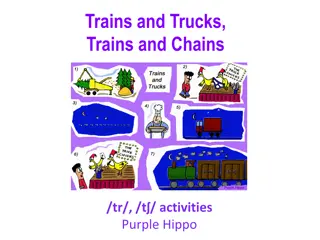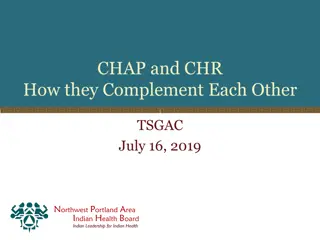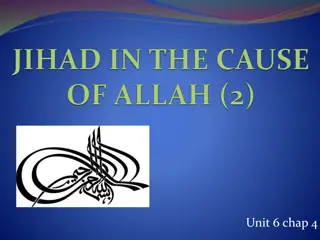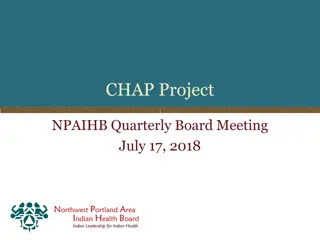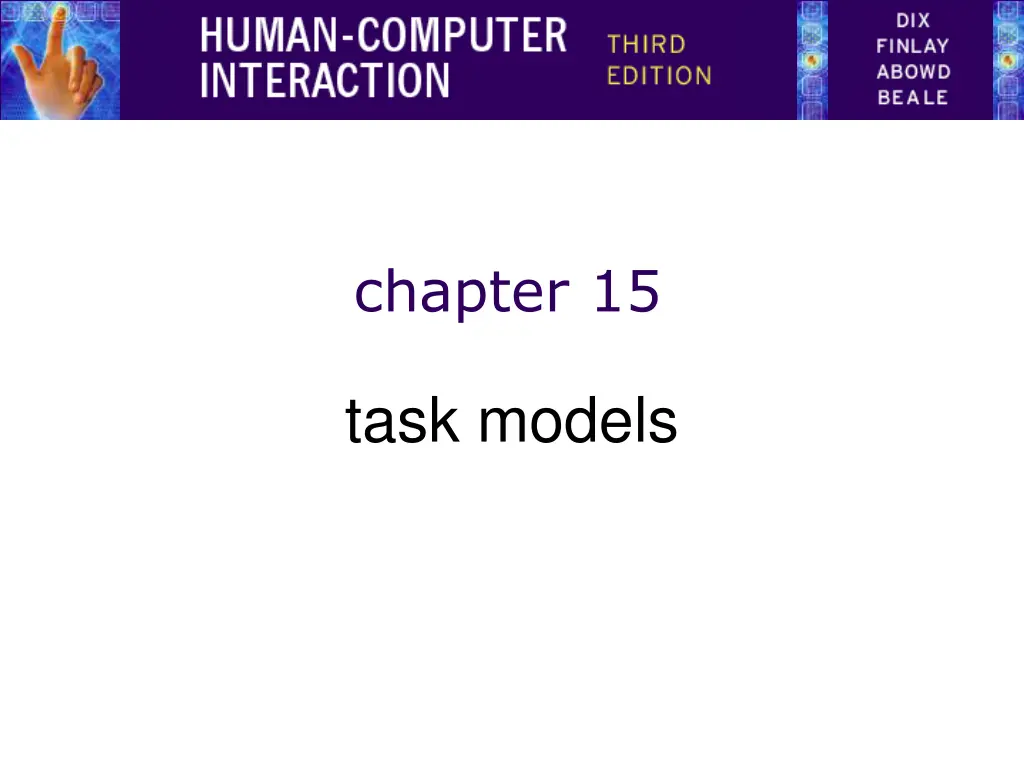
Understanding Task Analysis Techniques
Explore the concept of Task Analysis, methods to analyze people's jobs, and different approaches to task decomposition. Learn how to generate hierarchies and textual descriptions for effective task organization.
Download Presentation

Please find below an Image/Link to download the presentation.
The content on the website is provided AS IS for your information and personal use only. It may not be sold, licensed, or shared on other websites without obtaining consent from the author. If you encounter any issues during the download, it is possible that the publisher has removed the file from their server.
You are allowed to download the files provided on this website for personal or commercial use, subject to the condition that they are used lawfully. All files are the property of their respective owners.
The content on the website is provided AS IS for your information and personal use only. It may not be sold, licensed, or shared on other websites without obtaining consent from the author.
E N D
Presentation Transcript
chapter 15 task models
What is Task Analysis? Methods to analyse people's jobs: what people do what things they work with what they must know
An Example in order to clean the house get the vacuum cleaner out fix the appropriate attachments clean the rooms when the dust bag gets full, empty it put the vacuum cleaner and tools away must know about: vacuum cleaners, their attachments, dust bags, cupboards, rooms etc.
Approaches to task analysis Task decomposition splitting task into (ordered) subtasks Knowledge based techniques what the user knows about the task and how it is organised Entity/object based analysis relationships between objects, actions and the people who perform them lots of different notations/techniques
general method observe collect unstructured lists of words and actions organize using notation or diagrams
Differences from other techniques Systems analysis vs. Task analysis system design - focus - the user Cognitive models vs. Task analysis internal mental state - focus - external actions practiced `unit' task - focus - whole job
Task Decomposition Aims: describe the actions people do structure them within task subtask hierarchy describe order of subtasks Variants: Hierarchical Task Analysis (HTA) most common CTT (CNUCE, Pisa) uses LOTOS temporal operators
Textual HTA description Hierarchy description ... 0. in order to clean the house 1. get the vacuum cleaner out 2. get the appropriate attachment 3. clean the rooms 3.1. clean the hall 3.2. clean the living rooms 3.3. clean the bedrooms 4. empty the dust bag 5. put vacuum cleaner and attachments away ... and plans Plan 0: do 1 - 2 - 3 - 5 in that order. when the dust bag gets full do 4 Plan 3: do any of 3.1, 3.2 or 3.3 in any order depending on which rooms need cleaning N.B. only the plans denote order
Generating the hierarchy 1 get list of tasks 2 group tasks into higher level tasks 3 decompose lowest level tasks further Stopping rules How do we know when to stop? Is empty the dust bag simple enough? Purpose: expand only relevant tasks Motor actions: lowest sensible level
Tasks as explanation imagine asking the user the question: what are you doing now? for the same action the answer may be: typing ctrl-B making a word bold emphasising a word editing a document writing a letter preparing a legal case
HTA as grammar can parse sentence into letters, nouns, noun phrase, etc. noun phrase syntax det noun . . . . . . . . . . . . letter lexical The cat sat on the mat.
parse scenario using HTA get out cleaner fix carpet head clean dinning room clean main bedroom empty dustbag clean sitting room put cleaner away 1. 2. 3.2. 3. 0. 3.3. 4. 3.2. 5. 0. in order to clean the house 1. get the vacuum cleaner out 2. get the appropriate attachment 3. clean the rooms 3.1. clean the hall 3.2. clean the living rooms 3.3. clean the bedrooms 4. empty the dust bag 5. put vacuum cleaner and attachments away
Refining the description Given initial HTA (textual or diagram) How to check / improve it? Some heuristics: paired actions restructure balance generalise e.g., where is `turn on gas' e.g., generate task `make pot' e.g., is `pour tea' simpler than making pot? e.g., make one cup .. or more
Types of plan fixed sequence - 1.1 then 1.2 then 1.3 optional tasks - if the pot is full 2 wait for events - when kettle boils 1.4 cycles - do 5.1 5.2 while there are still empty cups time-sharing - do 1; at the same time ... discretionary - do any of 3.1, 3.2 or 3.3 in any order mixtures - most plans involve several of the above
waiting is waiting part of a plan? or a task? generally task if busy wait you are actively waiting plan if end of delay is the event e.g. when alarm rings , when reply arrives in this example perhaps a little redundant TA not an exact science see chapter 19 for more on delays!
Knowledge Based Analyses Focus on: Objects used in task Actions performed + Taxonomies represent levels of abstraction
KnowledgeBased Example motor controls steering steering wheel, indicators engine/speed direct ignition, accelerator, foot brake gearing clutch, gear stick lights external headlights, hazard lights internal courtesy light wash/wipe wipers front wipers, rear wipers washers front washers, rear washers heating temperature control, air direction, fan, rear screen heater parking hand brake, door lock radio numerous!
Task Description Hierarchy Three types of branch point in taxonomy: XOR normal taxonomy object in one and only one branch AND object must be in both multiple classifications OR weakest case can be in one, many or none wash/wipe AND function XOR position XOR wipe front wipers, rear wipers wash front washers, rear washers front front wipers, front washers rear rear wipers, rear washers
Larger TDH example kitchen item AND /____shape XOR / |____dished mixing bowl, casserole, saucepan, / | soup bowl, glass / |____flat plate, chopping board, frying pan /____function OR {____preparation mixing bowl, plate, chopping board {____cooking frying pan, casserole, saucepan {____dining XOR |____for food plate, soup bowl, casserole |____for drink glass N.B. /|{ used for branch types.
More on TDH Uniqueness rule: can the diagram distinguish all objects? e.g., plate is: kitchen item/shape(flat)/function{preparation,dining(for food)}/ nothing else fits this description Actions have taxonomy too: kitchen job OR |____ preparation beating, mixing |____ cooking frying, boiling, baking |____ dining pouring, eating, drinking
Abstraction and cuts After producing detailed taxonomy cut to yield abstract view That is, ignore lower level nodes e.g. cutting above shape and below dining, plate becomes: kitchen item/function{preparation,dining}/ This is a term in Knowledge Representation Grammar (KRG) These can be more complex: e.g. beating in a mixing bowl becomes: kitchen job(preparation) using a kitchen item/function{preparation}/
Entity-Relationship Techniques Focus on objects, actions and their relationships Similar to OO analysis, but includes non-computer entities emphasises domain understanding not implementation Running example Vera's Veggies a market gardening firm owner/manager: Vera Bradshaw employees: Sam Gummage and Tony Peagreen various tools including a tractor `Fergie two fields and a glasshouse new computer controlled irrigation system
Objects Start with list of objects and classify them: Concrete objects: simple things: spade, plough, glasshouse Actors: human actors: Vera, Sam, Tony, the customers what about the irrigation controller? Composite objects: sets: the team = Vera, Sam, Tony tuples: tractor may be < Fergie, plough >
Attributes To the objects add attributes: Object Pump3 simple irrigation pump Attributes: status: on/off/faulty capacity: 100 litres/minute N.B. need not be computationally complete
Actions List actions and associate with each: agent who performs the actions patient which is changed by the action instrument used to perform action examples: Sam (agent) planted (action) the leeks (patient) Tony dug the field with the spade (instrument)
Actions (ctd) implicit agents read behind the words `the field was ploughed' by whom? indirect agency the real agent? `Vera programmed the controller to irrigate the field' messages a special sort of action `Vera told Sam to ... ' r les an agent acts in several r les Vera as worker or as manager
example objects and actions Object Sam human actor Actions: S1: drive tractor S2: dig the carrots Object glasshouse simple Attribute: humidity: 0-100% Object Irrigation Controller non-human actor Actions: IC1: turn on Pump1 IC2: turn on Pump2 IC3: turn on Pump3 Object Vera human actor Actions: as worker V1: plant marrow seed V2: program irrigation controller Actions: as manager V3: tell Sam to dig the carrots the proprietor Object Marrow simple Actions: M1: germinate M2: grow Object the men composite Comprises: Sam, Tony
Events when something happens performance of action Sam dug the carrots spontaneous events the marrow seed germinated the humidity drops below 25% timed events at midnight the controller turns on
Relationships object-object social - Sam is subordinate to Vera spatial - pump 3 is in the glasshouse action-object agent (listed with object) patient and instrument actions and events temporal and causal Sam digs the carrots because Vera told him temporal relations use HTA or dialogue notations. show task sequence (normal HTA) show object lifecycle
example events and relations Events: Ev1: humidity drops below 25% Ev2: midnight Relations: action-event before ( V1, M1) the marrow must be sown before it can germinate Relations: object-object location ( Pump3, glasshouse ) location ( Pump1, Parker s Patch ) triggers ( Ev1, IC3 ) when humidity drops below 25%, the controller turns on pump 3 Relations: action-object patient ( V3, Sam ) Vera tells Sam to dig patient ( S2, the carrots ) Sam digs the carrots ... instrument ( S2, spade ) ... with the spade causes ( V2, IC1 ) the controller turns on the pump because Vera programmed it
Sources of Information Documentation N.B. manuals say what is supposed to happen but, good for key words and prompting interviews Observation formal/informal, laboratory/field (see Chapter 9) Interviews the expert: manager or worker? (ask both!)
Early analysis Extraction from transcripts list nouns (objects) and verbs (actions) beware technical language and context: `the rain poured vs. `I poured the tea Sorting and classifying grouping or arranging words on cards ranking objects/actions for task relevance (see ch. 9) use commercial outliner Iterative process: but costly, so use cheap sources where available data sources analysis
Uses manuals & documentation Conceptual Manual from knowledge or entity relations based analysis good for open ended tasks Procedural How to do it Manual from HTA description good for novices assumes all tasks known To make cups of tea Make pot of tea once water has boiled boil water see page 2 empty pot make pot see page 3 wait 4 or 5 minutes pour tea see page 4 warm pot put tea leaves in pot pour in boiling water page 1 page 3
Uses requirements & design Requirements capture and systems design lifts focus from system to use suggests candidates for automation uncovers user's conceptual model Detailed interface design taxonomies suggest menu layout object/action lists suggest interface objects task frequency guides default choices existing task sequences guide dialogue design NOTE. task analysis is never complete rigid task based design inflexible system



